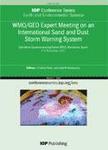版权所有:内蒙古大学图书馆 技术提供:维普资讯• 智图
内蒙古自治区呼和浩特市赛罕区大学西街235号 邮编: 010021

作者机构:Undergraduate Program of Geophysical Engineering Faculty of Mining and Petroleum Engineering Institut Teknologi Bandung Global Geophysics Research Group Faculty of Mining and Petroleum Engineering Institut Teknologi Bandung Exploration and Engineering Seismology Research Group Faculty of Mining and Petroleum Engineering Institut Teknologi Bandung
出 版 物:《IOP Conference Series: Earth and Environmental Science》
年 卷 期:2017年第62卷第1期
摘 要:Development of geothermal production can be conducted in several ways, one of them analyses the fracture or crack and structure within the reservoir. Due to low permeability and porosity value within the reservoir in geothermal field. This crack or fracture provide porosity for fluid storage and permeability for fluid movement and play a major role in production from this kind of reservoir. Structure and polarization direction can be derived from anisotropy parameter and seismic velocity parameter in geothermal field. In this study, we used micro-earthquake data of 1,067 events that were recorded by the average of 15 stations during almost 1-year measurement. We used anisotropy parameter using 3-D shear-wave splitting (SWS) tomography method to represent the distribution of anisotropy medium around the geothermal field. Two parameters produced from the S-wave analysis, which is polarization direction and delay time between fast S-wave and slow S-wave. To determine SWS parameters, we used a rotation of horizontal seismogram including N-S component and E-W component. Furthermore, we used short-time fourier transform (STFT) to calculate lag time and time window based on wave periods. Two horizontal components have been rotated from azimuth 0° to 180° with an increment of 1°. Cross-correlation coefficient used every azimuth of two horizontal components based on delay time with predetermined time window obtained by STFT. When cross-correlation coefficient is high, the corresponding value of delay time and azimuth are chosen as the polarization direction and delay time of SWS. Normalized time different divided by total ray length was used to determine the distribution of crack density. Through correlation of seismic velocity model, crack density, and 3-D anisotropy tomography, we can delineate a geothermal reservoir model. Our results show, high degree of anisotropy and crack density occur in the northern and eastern part of PR geothermal field for further development.